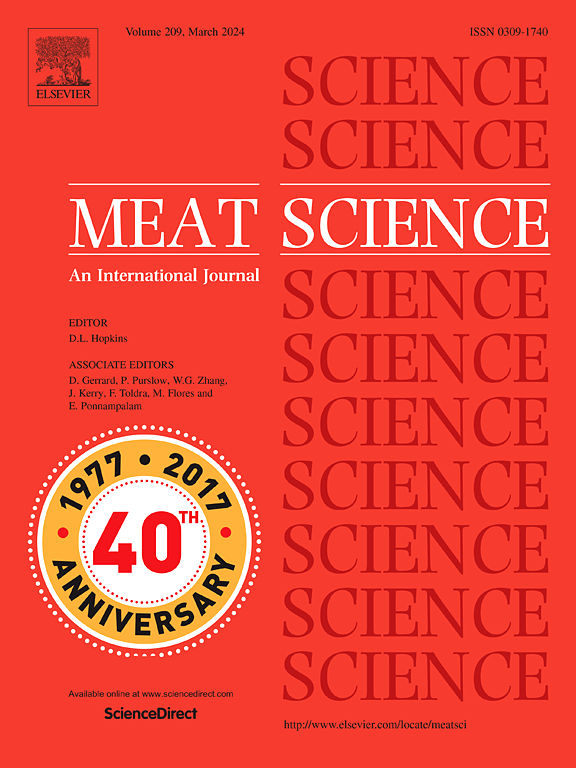低NaCl水平下羧甲基纤维素钠对炸牛肉饼PhIP、Harman和Norharman形成的抑制潜力
IF 6.1
1区 农林科学
Q1 Agricultural and Biological Sciences
引用次数: 0
摘要
研究低盐条件下羧甲基纤维素钠(CMCNa)对煎炸牛肉饼中杂环芳香胺(HAAs)生成的抑制作用。在1% NaCl水平下,将0.5 ~ 1.5%的CMC-Na添加到牛肉肉糜中,发现煎炸后HAAs的形成明显受到抑制(P <;0.05)。1% NaCl + 1.5% CMC-Na处理的抑制作用有统计学意义(P <;0.05)。具体而言,与对照处理相比,该处理有效降低了Harman、Norharman和PhIP含量,分别为58.9%、66.1%和67%。CMC-Na在低盐条件下通过保水机制抑制HAAs的生成,使肉糜形成紧密的三维凝胶网络结构,从而阻止固定水向自由水迁移。这有助于减缓牛肉饼表面的温升,同时降低HAAs前体的热解速率。CMC-Na可作为低盐条件下煎炸牛肉饼的食品添加剂,显著减少HAA的形成,提高食品安全性。本文章由计算机程序翻译,如有差异,请以英文原文为准。
The inhibition potentiality of sodium carboxymethyl cellulose on PhIP, Harman, and Norharman formation of fried beef patties at low NaCl level
The objective of this study was to investigate the inhibitory effect of sodium carboxymethyl cellulose (CMC![]() Na) on the formation of heterocyclic aromatic amines (HAAs) in fried beef patties under low salt conditions. The 0.5–1.5 % of CMC-Na was introduced to minced beef at 1 % NaCl level, and the formation of HAAs was found to be significantly inhibited after fried (P < 0.05). The inhibition observed in the treatment containing 1 % NaCl +1.5 % CMC-Na was found to be statistically significant (P < 0.05). Specifically, compared to the control treatment, the contents of Harman, Norharman and PhIP were effectively reduced by 58.9 %, 66.1 %, and 67 %, respectively, in this treatment. CMC-Na inhibited the generation of HAAs through a water retention mechanism under low-salt conditions and formed a tight three-dimensional gel network structure of the minced meat, thus preventing the migration of fixed water to free water. This helped to mitigate the temperature rise on the surface of the beef patty while reducing the rate of pyrolysis of precursors of HAAs. CMC-Na can be utilized as a food additive during the preparation of fried beef patties under low-salt conditions to significantly diminish HAA formation and enhance food safety.
Na) on the formation of heterocyclic aromatic amines (HAAs) in fried beef patties under low salt conditions. The 0.5–1.5 % of CMC-Na was introduced to minced beef at 1 % NaCl level, and the formation of HAAs was found to be significantly inhibited after fried (P < 0.05). The inhibition observed in the treatment containing 1 % NaCl +1.5 % CMC-Na was found to be statistically significant (P < 0.05). Specifically, compared to the control treatment, the contents of Harman, Norharman and PhIP were effectively reduced by 58.9 %, 66.1 %, and 67 %, respectively, in this treatment. CMC-Na inhibited the generation of HAAs through a water retention mechanism under low-salt conditions and formed a tight three-dimensional gel network structure of the minced meat, thus preventing the migration of fixed water to free water. This helped to mitigate the temperature rise on the surface of the beef patty while reducing the rate of pyrolysis of precursors of HAAs. CMC-Na can be utilized as a food additive during the preparation of fried beef patties under low-salt conditions to significantly diminish HAA formation and enhance food safety.
求助全文
通过发布文献求助,成功后即可免费获取论文全文。
去求助
来源期刊

Meat Science
工程技术-食品科技
CiteScore
12.60
自引率
9.90%
发文量
282
审稿时长
60 days
期刊介绍:
The aim of Meat Science is to serve as a suitable platform for the dissemination of interdisciplinary and international knowledge on all factors influencing the properties of meat. While the journal primarily focuses on the flesh of mammals, contributions related to poultry will be considered if they enhance the overall understanding of the relationship between muscle nature and meat quality post mortem. Additionally, papers on large birds (e.g., emus, ostriches) as well as wild-captured mammals and crocodiles will be welcomed.
 求助内容:
求助内容: 应助结果提醒方式:
应助结果提醒方式:


